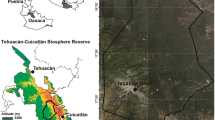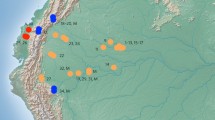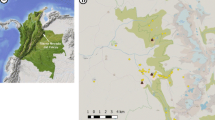Abstract
Tagua (Phytelephas aequatorialis Spruce) is a dioecious palm endemic to the forests and pastures of western Ecuador. Ethnobotanical studies from the early 20th century have described the market–based ecosystem services derived from its seed, known as vegetable ivory, but little is known about its non–market ecosystem services. In this paper, we investigate the local knowledge associated with all ecosystem services provided by the palm through focus group discussions within three communities in the Manabí Province of western Ecuador. We used a computer–assisted qualitative analysis to transcribe, analyze, and classify the transcripts using reports of use types. Participants identified a total of 28 ecosystem services: 13 provisioning, 7 regulating, 6 cultural, and 2 supporting services. The use type with the most frequent reports by respondents were plant–animal interactions (36), thatch roofs (19), and cultural identity (17). Generally, the results reveal that local people value tagua for its role as a key species supporting local fauna, the uses of their leaves in the traditional architecture, and as a natural resource that allows them to identify with their traditions. We discuss concerns reported by participants regarding the tagua trade, harvest hazards, and the loss of traditions associated with tagua.





Similar content being viewed by others
Literature Cited
Acosta-Solis, M. 1948. Tagua or vegetable ivory—A forest product of Ecuador. Economic Botany 2(1):46–57. https://doi.org/10.1007/BF02907918.
Anthelme, F., J. Lincango, C. Gully, N. Duarte, and R. Montúfar. 2011. How anthropogenic disturbances affect the resilience of a keystone palm tree in the threatened Andean cloud forest? Biological Conservation 144:1059–1067. https://doi.org/10.1016/j.biocon.2010.12.025.
Barfod, A. S., B. Bergmann, and H. B. Pedersen. 1990. The vegetable ivory industry: Surviving and doing well in Ecuador. Economic Botany 44(3):293–300. https://doi.org/10.1007/BF03183910.
Barfod, A. S., M. Hagen, and F. Borchsenius. 2011. Twenty–five years of progress in understanding pollination mechanisms in palms (Arecaceae). Annals of Botany 108(8):1503–1516. https://doi.org/10.1093/aob/mcr192.
Borchsenius, F., H. Borgtoft-Pedersen, and H. Balslev. 1998. Manual to the Palms of Ecuador. AAU Reports 37. Department of Systematic Botany. Aarhus, Denmark: University of Aarhus, Denmark in collaboration with Pontificia Universidad Católica del Ecuador.
Brokamp, G. 2015. Trade in palm products in north–western South America. In: Relevance and sustainability of wild plant collection in NW South America: Insights from the plant families Arecaceae and Krameriaceae, G. Brokamp, ed., 39–67. Wiesbaden, Germany: Springer Fachmedien. https://doi.org/10.1007/978–3–658–08696–1_3.
Brokamp, G., H. Borgtoft Pedersen, R. Montúfar, J. Jácome, M. Weigend, and H. Balslev. 2014. Productivity and management of Phytelephas aequatorialis (Arecaceae) in Ecuador. Annals of Applied Biology 164(2):257–269. https://doi.org/10.1111/aab.12098.
Cámara-Leret, R., N. Paniagua-Zambrana, H. Balslev, A. Barfod, J. C. Copete, and M. J. Macía. 2014. Ecological community traits and traditional knowledge shape palm ecosystem services in northwestern South America. Forest Ecology and Management 334:28–42. https://doi.org/10.1016/j.foreco.2014.08.019.
Cámara-Leret, R., J. C. Copete, H. Balslev, M. S. Gomez, and M. Macía. 2016. Amerindian and Afro–American perceptions of their traditional knowledge in the Chocó Biodiversity Hotspot. Economic Botany 70(2):160–175. https://doi.org/10.1007/s12231–016–9341–3.
Denzin, N. and Y. Lincoln, eds. 2011. The SAGE Handbook of Qualitative Research. London, United Kingdom: SAGE Publications.
Dodson, C. H. and A. H. Gentry. 1991. Biological extinction in western Ecuador. Annals of the Missouri Botanical Garden 78(2):273–295. https://doi.org/10.2307/2399563.
Escobar, S., O. H. Razafindratsima, R. Montúfar, and H. Balslev. 2020. Post–dispersal seed removal in a large–seeded palm by frugivore mammals in western Ecuador. Tropical Conservation Science 13:1–14. https://doi.org/10.1177/1940082920947041.
Galeano, G., S. Suárez, and H. Balslev. 1998. Vascular plant species count in a wet forest in the Chocó area on the Pacific coast of Colombia. Biodiversity & Conservation 7(12):1563–1575. https://doi.org/10.1023/A:1008802624275.
Garibaldi, A. and N. Turner. 2004. Cultural keystone species: Implications for ecological conservation and restoration. Ecology and Society 9(3):1. http://www.ecologyandsociety.org/vol9/iss3/art1/.
Ghysels, S., A. E. Estrada Léon, M. Pala, K. A. Schoder, J. Van Acker, and F. Ronsse. 2019. Fast pyrolysis of mannan–rich ivory nut (Phytelephas aequatorialis) to valuable biorefinery products. Chemical Engineering Journal 373:446–457. https://doi.org/10.1016/j.cej.2019.05.042.
González-Andrade, F. and J.-P. Chippaux. 2010. Snake bite envenomation in Ecuador. Transactions of The Royal Society of Tropical Medicine and Hygiene 104(9):588–591. https://doi.org/10.1016/j.trstmh.2010.05.006.
González-Jaramillo, V., A. Fries, R. Rollenbeck, J. Paladines, F. Oñate-Valdivieso, and J. Bendix. 2016. Assessment of deforestation during the last decades in Ecuador using NOAA–AVHRR satellite data. Erdkunde 70:217–235. https://doi.org/10.3112/erdkunde.2016.03.02.
Guerin, C., J. Serret, R. Montúfar, V. Vaissayre, A. Bastos-Siqueira, T. Durand-Gasselin, J. Tregear, F. Morcillo, and S. Dussert. 2020. Palm seed and fruit lipid composition: Phylogenetic and ecological perspectives. Annals of Botany 125(1):157–172. https://doi.org/10.1093/aob/mcz175.
Kahn, F. and J.-J. de Granville. 1992. Palms in forest ecosystems of Amazonia. Berlin: Springer–Verlag. https://doi.org/10.1007/978–3–642–76852–1.
Koziol, M. J. and H. B. Pedersen. 1993. Phytelephas aequatorialis (Arecaceae) in human and animal nutrition. Economic Botany 47(4):401–407. https://doi.org/10.1007/BF02907355.
Lozada, T., G. H. J. de Koning, R. Marché, A.-M. Klein, and T. Tscharntke. 2007. Tree recovery and seed dispersal by birds: Comparing forest, agroforestry and abandoned agroforestry in coastal Ecuador. Perspectives in Plant Ecology, Evolution and Systematics 8(3):131–140. https://doi.org/10.1016/j.ppees.2006.10.001.
Macía, M. J., P. J. Armesilla, R. Cámara-Leret, N. Paniagua-Zambrana, S. Villalba, H. Balslev, and M. Pardo-de-Santayana. 2011. Palm uses in northwestern South America: A quantitative review. Botanical Review 77:462–570.
Martinez Tyson, D., E. Teran, L. U.-L. Dào, V. Chee, I. Hernández, M. Flores, M. Reina Ortiz, R. Izurieta, and J. A. Baldwin. 2021. “Cancer is in style”: Lifestyle change and the perceived impact of globalization on Andean indigenous communities in Ecuador. Ethnicity & Health 26(2):153–167. https://doi.org/10.1080/13557858.2018.1493437.
Millennium ecosystem assessment. 2005. Ecosystems and human well–being: Synthesis. Washington, D.C.: Island Press.
Montúfar, R. and N. Pitman. 2003. Phytelephas aequatorialis. The IUCN Red List of Threatened Species 2003:e.T43981A10836113. https://doi.org/10.2305/IUCN.UK.2003.RLTS.T43981A10836113.en.
Montúfar, R., F. Anthelm, J.-C. Pintaud, and H. Balslev. 2011. Disturbance and resilience in tropical American palm populations and communities. Botanical Review 77(4):426–461.
Montúfar, R., G. Brokamp, and J. Jácome. 2013. Capítulo 13 Phytelephas aequatorialis. In: Palmas ecuatorianas: Biología y uso sostenible, R. Valencia, R. Montúfar, H. Navarrete, and H. Balslev, eds., 187–201. Quito: Herbario QCA de la PUCE.
Morgan, D. 1996. Focus Groups. Annual Review of Sociology 22:129–152.
MPCEIP [Ministerio de Producción, Comercio Exterior, Inversiones y Pesca]. 2019. Campaña “La Nuez de Marfil, Tesoro del Ecuador” promociona la tagua en China. https://www.produccion.gob.ec/campana–la–nuez–de–marfil–tesoro–del–ecuador–promociona–la–tagua–en–china/. Accessed 1 Feb 2021.
Murphy, P. F. 1991. Can we see the forest for the trees?: A case study of marketing non–timber forest products. M.Sc. thesis, Department of Urban Studies and Planning, Massachusetts Institute of Technology, United States of America.
Myers, N., R. A. Mittermeier, C. G. Mittermeier, G. A. B. da Fonseca, and J. Kent. 2000. Biodiversity hotspots for conservation priorities. Nature 403(6772):853–858. https://doi.org/10.1038/35002501.
Palacios, W. A. and J. Pérez. 2014. Ecología, usos y manejo de la tagua (Phytelephas aequatorialis Spruce) en la cordillera de Chongón Colonche. Acta Horticulturae 1030:39–48. https://doi.org/10.17660/ActaHortic.2014.1030.4.
Pardo-Rojas, M. 1987. Vista de Regionalizacion de indígenas Choco Datos etnohistóricos, lingüísticos y asentamientos actuales. Boletín Museo Del Oro 18:46–63.
Pérez-Escobar, O. A., E. Lucas, C. Jaramillo, A. Monro, S. K. Morris, D. Bogarín, D. Greer, S. Dodsworth, J. Aguilar-Cano, A. Sanchez Meseguer, and A. Antonelli. 2019. The origin and diversification of the hyperdiverse flora in the Chocó Biogeographic Region. Frontiers in Plant Science 10:1328. https://doi.org/10.3389/fpls.2019.01328.
Pincebourde, S. S., R. Montúfar, E. Páez, and O. Dangles. 2016. Heat production by an Ecuadorian palm. Frontiers in Ecology and the Environment 14(10):571–572. https://doi.org/10.1002/fee.1442.
Rodríguez-Guerra, A. 2019. Bothrops asper. In: Reptiles del Ecuador. Versión 2019.0, O. Torres-Carvajal, G. Pazmiño-Otamendi, and D. Salazar-Valenzuela, eds. Museo de Zoología, Pontificia Universidad Católica del Ecuador. https://bioweb.bio/faunaweb/reptiliaweb/FichaEspecie/Bothrops%20asper. Accessed 14 Oct 2020.
Roitman, K. 2008. Hybridity, Mestizaje and Montubios in Ecuador. QEH Working Paper Series–QEHWPS165. https://ideas.repec.org/p/qeh/qehwps/qehwps165.html.
Runk, J. V. 1998. Productivity and sustainability of a vegetable ivory palm (Phytelephas aequatorialis, Arecaceae) under three management regimes in northwestern Ecuador. Economic Botany 52(2):168–182. https://doi.org/10.1007/BF02861205.
Sáenz-Ozaetta, C., J. Olives-Maldonado, V. Solórzano-Méndez, A. Laínez-Quinde, M. Mera-Cedeño, G. Parrales-Loor, M. Reyes-Tomalá, E. Mendoza-Tarabó, J. Villao-Viteri, J. Candell-Soto, and L. Valencia-Cruzatty. 2013. Plan de Desarrollo Endógeno. Estudio de caso: Comuna Dos Mangas, Provincia de Santa Elena, Santa Elena, Ecuador. México: Ecorfan. https://www.ecorfan.org/libros/Plan%20de%20desarrollo%20end%C3%B3geno.pdf. Accessed 20 March 2021.
Schebesta, H. 2018. Content analysis software in legal research: A proof of concept using ATLAS.ti. Tilburg Law Review 23(1–2):23–33. https://doi.org/10.5334/tilr.1.
Schneider, E., R. Cámara-Leret, A. Barfod, and C. S. Weckerle. 2017. Palm use by two Chachi communities in Ecuador: A 30–year reappraisal. Economic Botany 71(4):342–360. https://doi.org/10.1007/s12231–017–9397–8.
SICES (Sistema Integrado de Conocimiento y Estadística Social de Ecuador). 2010. Módulo Estadística. http://www.conocimientosocial.gob.ec/ (1 October 2019).
de la Torre, L., H. Navarrete, P. Muriel, M. J. Macía, and H. Balslev. 2008. Enciclopedia de Plantas Útiles del Ecuador. Quito and Aarhus: Herbario QCA de la Escuela de Ciencias Biológicas de la Pontificia Universidad Católica del Ecuador & Herbario AAU del Departamento de Ciencias Biológicas de la Universidad de Aarhus, Dinamarca. https://www.academia.edu/30089423/Enciclopedia_de_Plantas_U_tiles_del_Ecuador.
Valenzuela Cárdenas, P. 2011. Análisis territorial de la cuenca del río Ayampe: Una mirada desde la relación de los actores sociales con los recursos naturales. M.Sc. thesis, Programa de Estudios del Desarrollo y Territorio, Facultad Latinoamericana de Ciencias Sociales, Sede Ecuador.
Van Eeuwijk, P. and Z. Angehrn. 2017. How to … Conduct a Focus Group Discussion (FGD). Methodological Manual [Other]. Basel: Swiss Tropical and Public Health Institute, University of Basel. http://edoc.unibas.ch/57173/. Accessed 23 Jan 2019.
Acknowledgments
We thank the members of the Dos Mangas, Dos Bocas, and Matapalo communities for their openness to be part of this study and their hospitality. We thank the TRAFINO company and its staff, especially Paulina Ormaza and Andrea García, for their support during our fieldwork. José Miguel Ayala and Nicole Alfaro collaborated in the transcription of the audios and Santiago Palacios supported the researchers during the fieldwork. We thank the editor, associate editor, and two anonymous reviewers for their valuable comments and suggestions. We also thank Thomas Auffray, Sophie Caillon, and Sylvain Pincebourde for their helpful feedback on an earlier version of this manuscript. RM and MA are grateful for the support of the Pontificia Universidad Católica del Ecuador and the Universidad Central del Ecuador, respectively. The authors also thank the International Joint Laboratory BIOINCA for funding this work. SA and JG thank the University of New Hampshire’s Hamel Center for Undergraduate Research for funding this work.
Author information
Authors and Affiliations
Corresponding author
Ethics declarations
Competing interests
The authors declare that no competing interests exist.
Rights and permissions
About this article
Cite this article
Montúfar, R., Gehrung, J., Ayala, M.A. et al. Identifying the Ecosystems Services of the Ivory Palm (Phytelephas aequatorialis Spruce): A Qualitative Study from the Central Coast of Ecuador. Econ Bot 76, 300–318 (2022). https://doi.org/10.1007/s12231-022-09552-9
Received:
Accepted:
Published:
Issue Date:
DOI: https://doi.org/10.1007/s12231-022-09552-9




